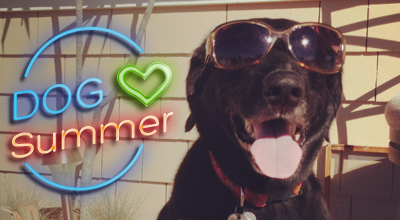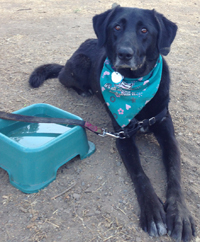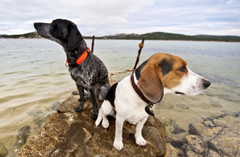
Dog Days of Summer
 Friends visiting a beach in Florida observed a small terrier racing into the water to retrieve a ball and return it to his owner, over and over again. What made this remarkable were the swim goggles the dog was wearing.
Friends visiting a beach in Florida observed a small terrier racing into the water to retrieve a ball and return it to his owner, over and over again. What made this remarkable were the swim goggles the dog was wearing.
Another nearby dog was wearing big sunglasses, a hat, and a sundress! Cute, yes, but not altogether frivolous as we learn how dogs can suffer from the challenges of summer.
Sunburn
Dogs can get sunburned just as people do. The skin becomes sensitive and may turn red, blister, and scab. Dogs with short white hair and dogs with thick hair that’s been trimmed for the summer can be more susceptible to sunburn.
If your dog is vulnerable, protect him from sunburn by applying sunscreen to the skin of his head and back. You may use a sunscreen designed for infants that contains no zinc. And there are sunscreens created specifically for dogs available at local pet stores.
Overheating
One of the biggest dangers in summer is the overheated car. Leaving a dog in the car, even with the windows open, is an invitation for heat stroke. As humans, we sweat through the skin on our entire body to cool down. The dog has no similar way to regulate his body temperature and can quickly become overheated.
Signs of a stroke in a dog are dizziness, unsure footing, and being disoriented. The bigger and longer the tongue is as they pant, the more likely they are to have heat exhaustion.
Dehydration
 In the summertime, dogs enjoy a nap in the sun. Make sure your dog has access to clean water at all times—and shade. If a dog becomes dehydrated, his gums will feel dry, tacky, or sticky to your touch. For another simple test, gently pinch and lift the skin behind the dog’s shoulder blades—creating a “tent.” When you release it, if the skin is slow to settle back, the dog is dehydrated. In an extreme case, an emergency visit to the veterinarian is in order for quick rehydration with an IV or subcutaneous injection.
In the summertime, dogs enjoy a nap in the sun. Make sure your dog has access to clean water at all times—and shade. If a dog becomes dehydrated, his gums will feel dry, tacky, or sticky to your touch. For another simple test, gently pinch and lift the skin behind the dog’s shoulder blades—creating a “tent.” When you release it, if the skin is slow to settle back, the dog is dehydrated. In an extreme case, an emergency visit to the veterinarian is in order for quick rehydration with an IV or subcutaneous injection.
Swimming
 Many dogs love to swim, but not every dog is a natural swimmer. Most dogs can paddle, but getting out of a swimming pool can be difficult unless you provide a ramp or other dog-tailored means of egress.
Many dogs love to swim, but not every dog is a natural swimmer. Most dogs can paddle, but getting out of a swimming pool can be difficult unless you provide a ramp or other dog-tailored means of egress.
In addition, chemicals in swimming pool water can be harmful to a dog’s GI tract. Even the water in a local creek can contain single-cell organisms such as Giardia that can cause diarrhea. Swimming is good exercise and cooling in the summer. Just be aware of possible risks associated with the activity.
Summary
Most of the hazards of summer are easily avoidable with simple common sense. Our pets want to please us, and they can’t tell us how they are feeling or what they are afraid of. We have to be alert to any distress they may experience. We have made a sacred promise to give them care throughout their lives, and they reward us with their unconditional love. How precious is that?
 About the Author
About the AuthorJeremy Lindston Robinson, our Vice President
Image courtesy of federico stevanin / FreeDigitalPhotos.net
